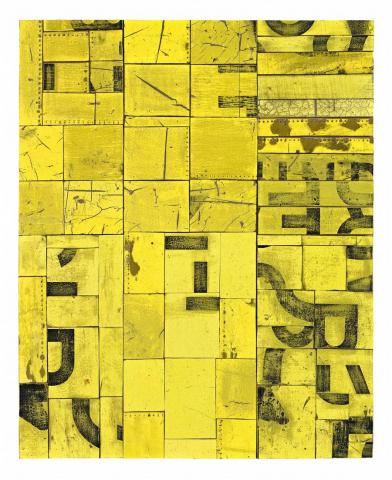A CERTAIN SMILE, 1994-95
Rosalie Gascoigne
retro-reflective road signs on wood
94.0 x 77.0 cm
signed, dated and inscribed verso: Rosalie Gascoigne / 1994-1995 /A Certain Smile
Roslyn Oxley9 Gallery, Sydney
Private collection, Sydney
Rosalie Gascoigne, Roslyn Oxley9 Gallery, Sydney, 23 August - 16 September 1995, cat. 17 (label attached verso)
MacDonald, V., Rosalie Gascoigne, Regaro, Sydney, 1998, p. 106
Few other artists 'own' materials in the way that Rosalie Gascoigne has made the scratched and weathered retro-reflective road signs, so admired, her signature works. Indeed, it would be virtually impossible for another artist to employ this material without having their work immediately placed in a framework that refers to, or is compared with Gascoigne's, such is its strength. However, it is not only the material which holds our fascination with these objects, but of Gascoigne's ability to arrange, assemble and organise them into works of such visual and poetic resonance.
When considered as a progression from the artist's early interest and indeed mastery of the Japanese floral arrangement technique, Ikebana, there is a natural logic to the development of her assemblages of found materials. As the artist's involvement in this discipline deepened, so did her feeling of constraint, '...with its hierarchic approach and deference to 'all things Japanese', particularly with regards to the selection and use of materials'.1 Yet the Eastern sensitivity to the honesty and beauty inherent in materials continued to underpin the artist's oeuvre.
Works such as A Certain Smile, bear the marks of existence, of age, of a previous purpose in a prior setting, deconstructed and reassembled into objects of renewed individual presence. They speak of the landscape, of the seasons, of journeys and of poetry. Once used to direct traffic or to signal changes in conditions (or warnings), in Gascoigne's hands these works evoke new visual sensations and further associations. 'The Australian landscape has a disorganized and random appearance. Rosalie Gascoigne's materials have a corresponding random quality, but they are subjected to formal and carefully proportioned arrangement. It is this regularity of arrangement which enables [her found materials] to refer to the ever-recurring, but never monotonous, rhythms of nature.'2
In Geoffrey O'Brien's enlightening essay on Gascoigne's working methods, Plain air / plain song, he investigates the artist's interest in 'concrete poetry', a term which describes a tradition in the use of non-syntactical arrangements of words 'which can be considered as both poems and drawings (as indeed can the later work of artists like Colin McCahon and Ian Hamilton Finlay).'3 He further explains, 'Gascoigne's art proposes a grammar of the incomplete and the untethered phrase' and in this respect a further allegiance with the Oriental culture is manifest. Just as the Japanese haiku in the original language is without syntax 'it exists as a visual 'motif'' so Gascoigne's art comprises a de- (and then re-) constructed syntax, without beginning or end.'4
1. Gellatly, K., Rosalie Gascoigne, Council of Trustees of the National Gallery of Victoria, Melbourne, 2008, p. 11
2. Kirk, M., quoted in Rosalie Gascoigne: Plain Air, (introduction by Paula Savage) City Gallery Wellington and Victoria University Press, Wellington, 2004, p. 12
3. O'Brien G., Plain air / plain song, essay in Rosalie Gascoigne: Plain Air, City Gallery Wellington and Victoria University Press, Wellington, 2004, p. 42
4. Ibid., p. 43
DAMIAN HACKETT
